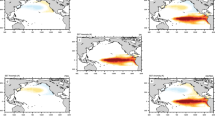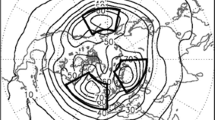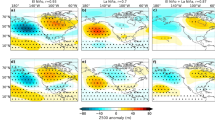Abstract
Changes in the winter atmospheric response to sea surface temperature (SST) anomalies associated with the El Niño-Southern Oscillation (ENSO) in a warmer climate conditions are estimated from the two 20-member ensembles made by an atmospheric general circulation model of intermediate complexity. Warmer climate is simulated by a modification in the radiation parameterisation that corresponds to the doubled CO2 concentration, and SST forcing is represented by the same SST anomalies as in current climate (1855–2002) experiment superimposed on the climatological SST that was obtained from a complex atmosphere-ocean general circulation model forced with the doubled CO2. SST anomalies in the Niño3.4 region, categorised into five classes, enabled a composite analysis of changes in the Northern Hemisphere tropical/extratropical teleconnections. The main features of the tropical–extratropical teleconnections are maintained in both experiments; for example, irrespective of the sign of SST anomalies, the amplitude of the atmospheric response is positively correlated with the intensity of ENSO event and the El Niño impact is stronger than that of La Niña of the same intensity. The strongest extratropical signal in the warmer climate, particularly significant for strong warm events, is found over the Pacific/North American region; however, this extratropical teleconnections is reduced in a warmer climate relative to the current climate. Over the North Atlantic/European region, a detectable signal linked to ENSO is found; this model response is significantly strengthened in the experiment with the doubled CO2 concentration. Such an atmospheric response in a warmer climate is found to be associated with changes in the mean state followed as well as in the jet waveguiding effect and stationary wave activity.












Similar content being viewed by others
Notes
Hadley Centre for Climate Prediction and Research, UK Meteorological Office, Exeter, UK.
Geophysical Fluid Dynamics Laboratory, Princeton, New Jersey, USA.
National Centers for Environmental Prediction, National Weather Service, National Oceanic and Atmospheric Administration, Camp Springs, Maryland, USA/National Center for Atmospheric Rresearch, Boulder, Colorado, USA.
Provided by the NOAA/OAR/ESRL PSD, Boulder, Colorado, USA (http://www.cdc.noaa.gov).
Provided through the ENSEMBLES webpage: http://ncas-climate.nerc.ac.uk/research/ensembles-rt4/coord_exp/boundary_conditions.html.
References
Benestad RE (2005) Climate change scenarios for northern Europe from multi-model IPCC AR4 climate simulations. Geophys Res Lett 32:L17704. doi:10.1029/2005GL023401
Bourke W (1974) A multilevel spectral model. I. Formulation and hemispheric integrations. Mon Wea Rev 102:687–701
Bracco A, Kucharski F, Kallummal R, Molteni F (2004) Internal variability, external forcing and climate trends in multidecadal AGCM ensembles. Clim Dyn 23:659–678
Brandefelt J (2006) Atmospheric modes of variability in a changing climate. J Clim 19:5934–5943
Brandefelt J, Kornich H (2008) Northern hemispheric stationary waves in climate projections. J Clim 21:6341–6353
Branković Č, Srnec L, Patarčić M (2010) An assessment of global and regional climate change based on the EH5OM climate model ensemble. Clim Change 98:21–49. doi:10.1007/s10584-009-9731-y
Branstator G (1983) Horizontal energy propagation in a barotropic atmosphere with meridional and zonal structure. J Atmos Sci 40:1689–1708
Branstator G (2002) Circumglobal teleconnections, the jet stream waveguide, and the north Atlantic oscillation. J Clim 15:1893–1910
Branstator G, Selten F (2009) “Modes of variability” and climate change. J Clim 22:2639–2658
Collins M (2000) Understanding uncertainties in the response of ENSO to greenhouse warming. Geophys Res Lett 27(21):3509–3512
Compo GP, Sardeshmukh PD (2009) Oceanic influences on recent continental warming. Clim Dyn 32:333–342
Deser C, Phillips AS (2009) Atmospheric circulation trends, 1950–2000: the relative roles of sea surface temperature forcing and direct atmospheric radiative forcing. J Clim 22:396–413
Enfield DB, Luis Cid S (1991) Low-frequency changes in El Niño-southern oscillation. J Clim 4:1137–1146
Fedorov AV, Dekens PS, McCarthy M, Ravelo AC, De Mencoal PB, Barreiro M (2006) The Pliocene paradox (mechanism for permanent El Niño). Science 312:1485–1489
Fraedrich K (1994) An ENSO impact on Europe? A review. Tellus 46A:541–552
Gates WL (1992) AMIP: the atmospheric model intercomparison project. Bull Amer Met Soc 73:1962–1970
Giorgi F, Coppola E (2007) European climate-change oscillation. Geophys Res Lett 34:L21703. doi:10.1029/2007GL031223
Gordon C, Cooper C, Senior CA, Banks HT, Gregory JM, Johns TC, Mitchell JFB, Wood RA (2000) The simulation of SST, sea ice extents and ocean heat transports in a version of the Hadley Centre coupled model without flux adjustments. Clim Dyn 16:147–168
Graham NE, Barnett TP (1987) Sea surface temperature, surface wind divergence, and convection over the tropical oceans. Science 238:657–659
Gregory JM, Stott PA, Cresswell DJ, Rayner NA, Gordon C, Sexton DMH (2002) Recent and future changes in Arctic sea ice simulated by the HadCM3 AOGCM. Geophys Res Lett 29(24):2175. doi:10.1029/2001GL14575
Guilyardi E, Wittenberg A, Fedorov A, Collins M, Wang C, Capotondi A, van Oldenburg GJ, Stockdale T (2009) Understanding El Niño in ocean-atmosphere general circulation models. Progress and challenges. Bull Amer Met Soc 90:325–340
Hannachi A, Turner AG (2008) Preferred structures in large scale circulation and the effect of doubling greenhouse gas concentration in HadCM3. Q J R Meteorol Soc 134:469–480
Hazeleger W, Severijns C, Seager R, Molteni F (2005) Tropical Pacific-driven decadel energy transport variability. J Clim 18:2037–2051
Held IM, Soden BJ (2006) Robust responses of the hydrological cycle to global warming. J Clim 19:5686–5699
Held IM, Suarez MJ (1994) A proposal for the intercomparison of dynamical cores of atmospheric general circulation models. Bull Amer Meteor Soc 75:1825–1830
Held IM, Ting M, Wang H (2002) Northern winter stationary waves: theory and modeling. J Clim 15:2125–2144
Henderson-Sellers B (1987) Modelling sea surface temperature rise resulting from increasing atmospheric carbon dioxide concentrations. Clim Change 11:349–359
Herceg Bulić I (2010) The sensitivity of climate response to the wintertime Niño3.4 sea surface temperature anomalies of 1855–2002. Int J Climatol, n/a. doi:10.1002/joc.2255
Herceg Bulić I, Branković Č (2006) Seasonal climate sensitivity to the sea-ice cover in an intermediate complexity AGCM. Geofizika 23:37–58
Herceg Bulić I, Branković Č (2007) ENSO forcing of the northern hemisphere climate in a large ensemble model simulations. Clim Dyn 28:231–254
Hirota T, Pomeroy JW, Granger RJ, Maule CP (2002) An extension of the force-restore method to estimating soil temperature at depth and evaluation for frozen soils under snow. J Geophys Res 107(D24):4767
Hoerling MP, Kumar A, Zhong M (1997) El Niño, La Niña, and the nonlinearity of their teleconnections. J Clim 10:1769–1786
Hoerling M, Kumar A, Eischeid J, Jha B (2008) What is causing the variability in global land temperature? Geophys Res Lett 35:L23712. doi:10.1029/2008GL035984
Hoskins BJ, Ambrizzi T (1993) Rossby wave propagation on a realistic longitudinally varying flow. J Atmos Sci 50:1661–1671
IPCC (2007) Climate change 2007: the physical science basis. In: Solomon S, Quin D, Manning M, Chen Z, Marquis M, Averyt KB, Tignor M, Miller HL (eds) Contribution of working group I to the fourth assessment report of the intergovernmental panel on climate change. Cambridge University Press, Cambridge, p 966
Jha B, Kumar A (2009) A comparison of the atmospheric response to ENSO in coupled and uncoupled model simulations. Mon Wea Rev 137:479–487. doi:10.1175/2008MWR2489.1
Jin Z, Stamnes K, Weeks WF, Tsay SC (1994) The effect of sea ice on the solar energy budget in the atmosphere-sea ice-ocean system: a model study. J Geophys Res 99(12):25281–25294
Joseph R, Ting M, Kushner PJ (2004) The global stationary wave response to climate change in a Coupled GCM. J Clim 17:540–556
Kalnay E et al (1996) The NCEP/NCAR 40-year reanalysis project. Bull Amer Meteorol Soc 77:437–471
Kiladis GN, Diaz HF (1989) Global climatic anomalies associated with extremes in the southern oscillation. J Clim 2:1069–1090
Knutson TR, Manabe S (1995) Time-mean response over the tropical Pacific to increased C02 in a coupled ocean-atmosphere model. J Clim 8:2181–2199
Kucharski F, Molteni F, Bracco A (2006) Decadal interactions between the western tropical Pacific and the North Atlantic Oscillation. Clim Dyn 26:79–91
Kucharski F, Bracco A, Yoo JH, Tompkins AM, Feudale L, Ruti P, Dell’Aquila A (2009) A Gill-Matsuno-type mechanism explains the tropical Atlantic influence on African and Indian monsoon rainfall. Q J R Meteorol Soc 135:569–579. doi:10.1002/qj.406
Manabe S, Stouffer R, Spelman M, Bryan K (1991) Transient responses of a coupled ocean-atmosphere model to gradual changes of atmospheric CO2. Part I. Annual mean response. J Clim 4:785–818
Meehl GA, Teng H (2007) Multi-model changes in El Niño teleconnections over North America in a future warmer climate. Clim Dyn 29:779–790. doi:10.1007/s00382-007-0268-3
Meehl GA, Washington WM (1996) El Nino-like climate change in a model with increased atmospheric CO2 concentrations. Nature 382:56–60
Meehl GA, Branstator GW, Washington WM (1993) Tropical Pacific interannual variability and CO2 climate change. J Clim 6:42–63
Meehl GA, Teng H, Branstator G (2006) Future changes of El Niño in two global coupled climate model. Clim Dyn 26:549–566. doi:10.1007/s00382-005-0098-0
Meehl GA et al (2007) Global climate projections. In: Solomon S, Qin D, Manning M, Chen Z, Marquis M, Averyt KB, Tignor M, Miller HL (eds) Climate change 2007: the physical science basis. Cambridge University Press, Cambridge
Merryfield WJ (2006) Changes to ENSO under CO2 doubling in multimodel ensemble. J Clim 19:4009–4027
Molteni F (2003) Atmospheric simulations using a GCM with simplified physical parameterizations. I: model climatology and variability in multi-decadal experiments. Clim Dyn 20:175–191
Müller W, Roeckner E (2008) ENSO teleconnections in projections of future climate in ECHAM5/MPI-OM. Clim Dyn 31:533–549
Peixoto JP, Oort AH (1992) Physics of climate. American Institute of Physics, New York
Pinto JG, Ulbrich U, Leckebusch GC, Spangehl T, Reyers M, Zacharias S (2007) Changes in storm track and cyclone activity in three SRES ensemble experiments with the ECHAM5/MPI-OM1 GCM. Clim Dyn 29:195–210
Pope V, Gallani ML, Rowntree PR, Stratton RA (2000) The impact of new physical parameterizations in the Hadley Centre climate model: HadAM3. Clim Dyn 16:123–146
Räisänen J (2002) CO2-induced changes in interannual temperature and precipitation variability in 19 CMIP2 experiments. J Clim 15:2395–2411
Rayner NA, Parker DE, Horton EB, Folland CK, Alexander LV, Rowell DP, Kent EC, Kaplan A (2003) Global analyses of SST, sea ice, and night marine air temperature since late nineteenth century. J Geophys Res 108:4407. doi:10.1029/2002JD002670
Ropelewski C, Halpert M (1986) North American precipitation and temperature patterns associated with the El Niño/Southern Oscillation (ENSO). Mon Wea Rev 114:2352–2362
Rowell DP (2005) A scenario of European climate change for the late twenty-first century: seasonal means and interannual variability. Clim Dyn 25:837–849
Selten FM, Branstator GW, Dijkstra HA, Kliphuis M (2004) Tropical origins for recent and future Northern Hemisphere climate change. Geophys Res Lett 31:L21205. doi:10.1029/2004GL020739
Shindell DT, Miller RL, Schmidt GA, Pandolfo L (1999) Simulation of recent northern winter climate trends by greenhouse-gas forcing. Nature 399:452–455. doi:10.1038/20905
Simmons AJ, Wallace JM, Branstator GW (1983) Barotropic wave propagation and instability, and atmospheric teleconnection patterns. J Atmos Sci 40:1363–1392
Smith TM, Reynolds RW (2004) Improved extended reconstruction of SST (1855–1997). J Clim 17:2466–2477
Stephenson DB, Held IM (1993) GCM response of northern winter stationary waves and storm tracks to increasing amounts of carbon dioxide. J Clim 6:1859–1870
Timmermann A, Oberhuber J, Bacher A, Esch M, Latif M, Roeckner E (1999) Increased El Niño frequency in a climate model forced by future greenhouse warming. Nature 398:694–696
Ting M, Hoerling MP, Xu T, Kumar A (1996) Northern hemisphere teleconnection patterns during extreme phases of the zonal-mean circulation. J Clim 9:2614–2633
Trenberth KE, Branstator GW, Karoly D, Kumar A, Lau NC, Ropelewski C (1998) Progress during TOGA in understanding and modelling global teleconnections associated with tropical sea surface temperatures. J Geophys Res 103:14291–14324
Turner AG, Inness PM, Slingo JM (2007) The effect of doubled CO2 and model basic state biases on the monsoon-ENSO system. I: mean response and interannual variability. Q J R Meteorol Soc 133:1143–1157. doi:10.1002/qj.82
Vecchi GA, Soden BJ (2007) Global warming and the weakening of the tropical circulation. J Clim 20:4316–4340
Vecchi GA, Soden BJ, Wittenberg AT, Held IM, Leetmaa A, Harrison MJ (2006) Weakening of tropical Pacific atmospheric circulation due to anthropogenic forcing. Nature 441:73–76
Acknowledgments
We thank to two reviewers and the editor J-C Duplessy for their valuable comments, suggestions and constructive criticism which greatly improved the original version of the manuscript. This work has been supported by the Ministry of Science, Educational and Sports of the Republic of Croatia (grants No. 119-1193086-1323 and 004-1193086-3035). Ivana Herceg Bulić also acknowledges support by the European Science Foundation (ESF) activity entitled Mediterranean Climate Variability and Predictability (MedCLIVAR). Fred Kucharski has been supported by the EU ENSEMBLES project 6th Framework Programme, contract GOCE-CT-2003-505539.
Author information
Authors and Affiliations
Corresponding author
Rights and permissions
About this article
Cite this article
Herceg Bulić, I., Branković, Č. & Kucharski, F. Winter ENSO teleconnections in a warmer climate. Clim Dyn 38, 1593–1613 (2012). https://doi.org/10.1007/s00382-010-0987-8
Received:
Accepted:
Published:
Issue Date:
DOI: https://doi.org/10.1007/s00382-010-0987-8




